Capsular contracture, breast implant removal and a lift – one patient’s story

Before and after bilateral explantation of previously placed silicone gel breast implants and a periareolar lift of the nipples and areola reduction (breast lift) in a 37 year old woman. Her breast augmentation was a few years ago in another state. She reported that she developed capsular contracture early on after surgery. She had massaged aggressively but the scar tissue persisted and was painful and worsening.
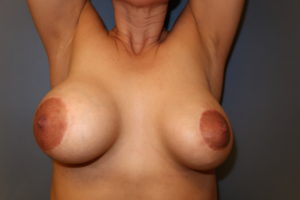
This patient’s breast implants were hard and contracted early on after her original surgery performed elsewhere.
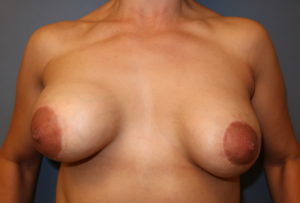
Her areolas had greatly increased in size and were out of proportion to her breasts. She never felt comfortable and wanted them out.
Why does excess scar tissue form in some cases? Capsular contracture is thought to be due to bacteria around the implant. The current theory of capsular contracture formation is the bacterial “biofilm theory” where bacteria are introduced into the space around the implant, often at the time of implant insertion. This can be riskiest if the implant is inserted through the areola or the armpit, where there are increased numbers of bacteria naturally.
The body senses there is a foreign invader at the site of implantation, and the body’s immune system mounts an inflammatory response. Excess scar tissue is deposited by the body around the breast implant, which can then contract around the implant to protect the body against the offending organism. This in essence is what happens during capsular contracture.
Bacteria that are involved in capsular contracture are usually found within the body. Many times, the organism is the same one that causes acne, Propionibacterium acnes, or P. acnes. Unfortunately, we cannot eradicate this organism, as it is a “commensal organism” that lives in the gut, in addition to the skin.
Breast implants are wonderful for many/most women, but they are not for everyone. In this case, this patient wanted her implants out. This procedure can usually be done under local anesthesia in the office. Once the implant is out, the excess scar tissue tends to fade away because it has nothing to fight against. A total capsulectomy is usually not required, so long as an implant will not be reinserted.
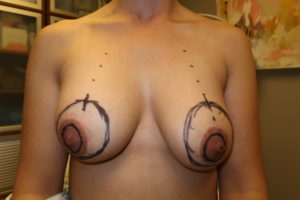
Markings for her breast implant removal and a lift of her nipples and reduction of her areola diameter are shown.
This patient underwent bilateral explantation and a “peri-areolar lift” as a straightforward in-office procedure under local anesthetic. The incision used to remove the implant was her old scar around the undersurface of the areola. A sample of scar tissue was taken from the inside and sent to the microbiology lab for culture and antibiotic sensitivities.
Additional skin was removed from around the areolas to reduce their diameter and to create a lift of the breasts and the most aesthetically pleasing results. This is called a “donut mastopexy”, “peri-areolar mastopexy” or “Benelli mastopexy”. So long as the breast is being made smaller, in this case from removal of the implants, the areolas do not tend to stretch out again.
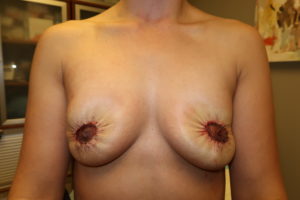
Immediately after surgery in the office, her areola incisions are puckered since they are closed in a “pursestring” technique. It takes at least 6 weeks for the puckers and pleats to begin to flatten. The breast will assume a more normal shape over the next two months.
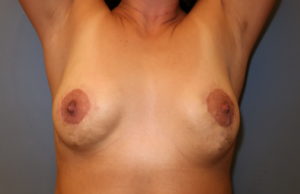
10 months after surgery, her breast skin has contracted and her scars are continuing to mature.

She loves her new areola size and is very satisfied with her decision to have this procedure.
Follow up photos are shown 10 months after surgery. And guess what her cultures grew: P. acnes bacteria! She felt that implants were just not for her, and she was right in this instance. She is thrilled to know that her scars will continue to improve and her areola diameter will continue to shrink as her areola continues to recovery its nerve contractile ability over time.
Note the significant reduction in her areola achieved with surgery. Removing the implants took pressure off her areolas and prevented them from stretching out again.
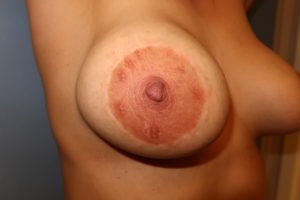
Before explantation and areola reduction

After breast implant removal and periareolar mastopexy
To learn more about breast implant removal and in-office areola reduction or other breast revision procedures, contact our office by calling 415-923-3067 or complete our online consultation request form.
View more before and after cases of explantation (implant removal) or saline breast implant deflation in our before and after gallery.
~ Karen M. Horton, M.D.
“Saving lives one breast at at a time…”
